#astrobiology
Text
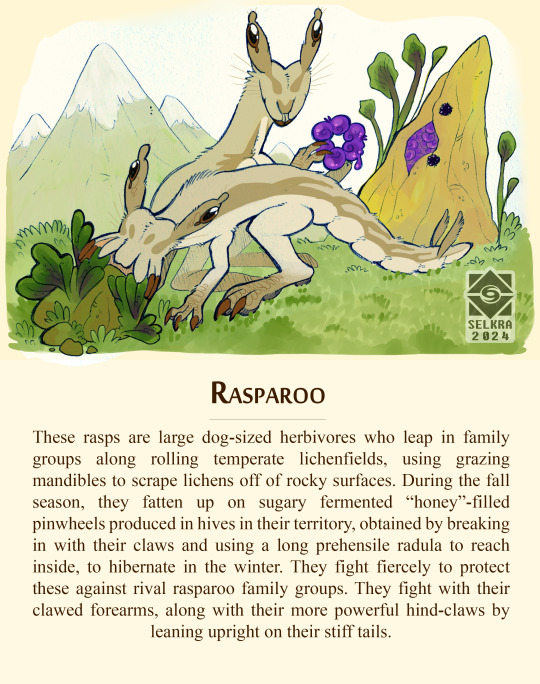

Cutting it close, but here's my entries for the Refugium Creature Design Contest! @simon-roy
The rasparoos are large dog-sized herbivores who leap in family groups along rolling temperate lichenfields, using grazing mandibles to scrape lichens off of rocky surfaces. During the fall season, they fatten up on sugary fermented “honey”-filled pinwheels produced in hives in their territory, obtained by breaking in with their claws and using a long prehensile radula to reach inside, to hibernate in the winter. They fight fiercely to protect these against rival rasparoo family groups. They fight with their clawed forearms, along with their more powerful hind-claws by leaning upright on their stiff tails.
Honey rings are social pinewheels that live in nests as colonies in temperate lichenfields. Their caste system includes workers, the smaller motile form who go out of the colony to collect vegetable matter during warmer seasons to ferment in their stomach acids and store as “honey” in the hive for the snowy seasons. The other caste are the reservoirs, who are blind, sessile and much larger than workers, with characteristic spiral body cavities to store a maximum amount of “honey”. Some of it seeps out of their bodies to stick with one another securely in the hive, aided by their gripping legs clinging to the walls of the hive.
I had a lot of fun with these guys! You can see concept sketches here because I think they're fun.
#refugium2024#selkra scribbles#my art#speculative biology#spec bio#speculative zoology#astrobiology#xenobiology#alien design#alien#artists on tumblr
60 notes
·
View notes
Text

Just some of our amazing work from 2023
#astronomy#nasa#astronomers#universe#astrophotography#nasa photos#astrophysics#outer space#nasawebb#hubble space telescope#i love astronomy#astronomy facts#astrography#astrobiology#astronauts#galaxies#galaxy#planetary science#planetary nebula#planet earth#plants#nebula#space exploration#space#science#solar system#science facts#space science#cosmos#the universe
59 notes
·
View notes
Text

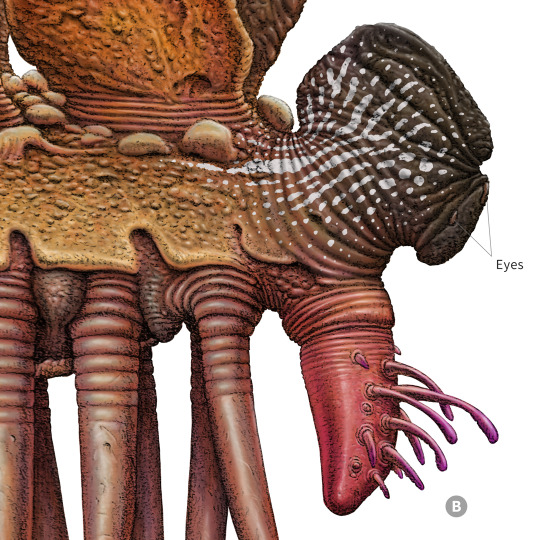



A Giant Forest Walker
#art#alien#space#creature#astrobiology#creature design#artist#exobiology#speculative evolution#worldbuilding#science fiction#scifiart
757 notes
·
View notes
Text
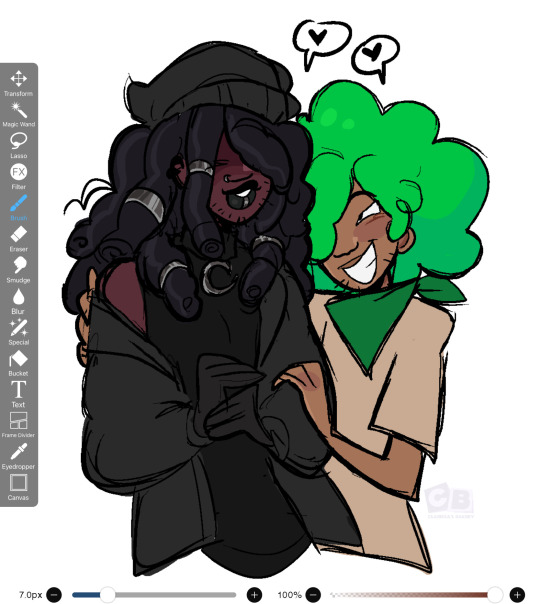
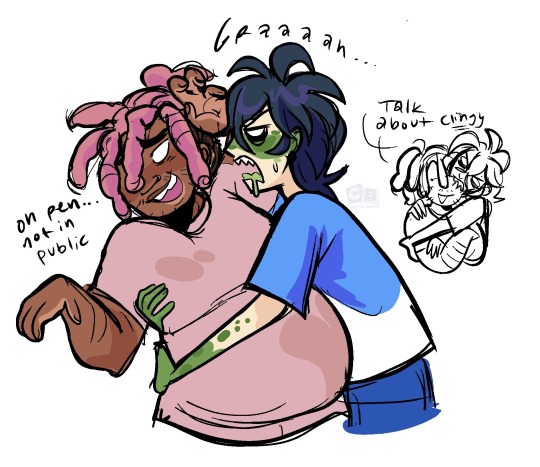
feeding the yaoi fans…
#my art#illustration#my art!#art#fan art#bfdi#battle for dream island#bfdi pen#bfdi eraser#bfdi black hole#bfdi tree#astrobiology#tpot#the power of two#penraser#bfb treehole#battle for bfdi#bfdi humanized#bfdi fanart#art request#character design
921 notes
·
View notes
Text
Sum black hole and tree doodles





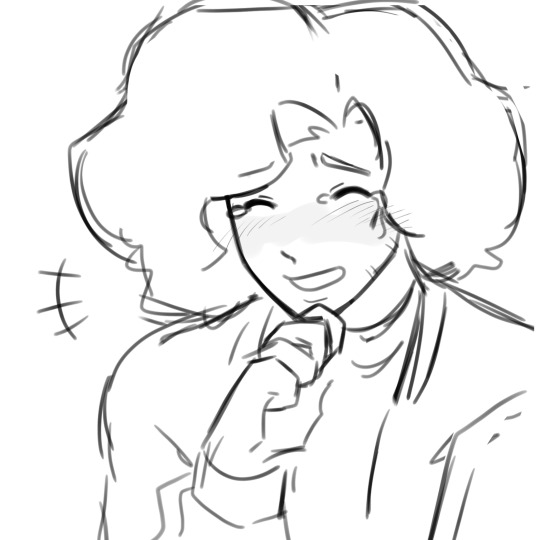
531 notes
·
View notes
Text
After reading lots about Mycorrhizal Networks and Trees and Bryozoans, I believe intelligent extraterrestrial life might be far more different from us than we assume.
It is so common to be stationary and fixed in place as an organism, I think aliens might not be able to grasp the concept of "travel," let alone space travel.
Communication is another difficulty. Would an organism adapted to communicate by chemical signals or by simply being linked physically to other organisms be able to comprehend the idea of sending messages between stars?
And then there is the issue of scale.
Organisms the size of, for instance, bees would take so long to establish a global/planet-wide communication, travel and trade network that progressing to interest in space travel might prove impossible.
As life forms go, humans are incredibly large. We are megafauna. The vast, vast majority of all living things on earth, even counting only multicellular things, are smaller than a human. It is deeply out of the ordinary for us to be so big.
This means that the spread of human populations, the impact of humans on their environment, and the ability of humans to communicate with each other over long distances progressed much, much faster than it would have if we were more average in size.
But it would also be detrimental if we were larger. The larger the creature, the harder it gets physically not only to overcome the gravity of your planet, but to create any type of transportation that can move you faster than you can move yourself.
The bigger you are, the more economical it becomes to either be in water or not move around at all.
2K notes
·
View notes
Text
astrobiology date gone wrong, awkward!!
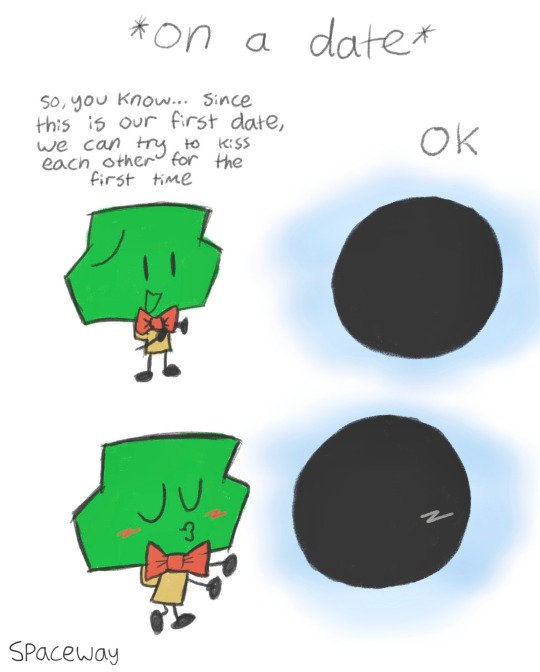

180 notes
·
View notes
Text





Блять что тут писать
#art#bfdi black hole#bfdi tree#bfdi gaty#bfdi two#tpot fanart#tpot#bfb#bfb treehole#astrobiology#three versions of the same drawing because I couldn’t decide what to pick idk#damn why does tumblr do this to the images' quality
331 notes
·
View notes
Text
Wet Beast Wednesday: tardigrades
Last week on Wet Beast Wednesday I covered the largest animals to ever exist on our planet. This week I'm going to pull a full 180 and cover the smallest animals yet on this series. Meet the tardigrade, the internet's favorite micro-animal the is said to be basically immortal. How true is that? Let's see.

(Image: an electron microscope image of a tardigrade. It looks a lot like a potato with eight stubby legs tipped with long claws. At the front is a small, circular mouth. It has no other discernable features. In the background are bits of plant matter that look like seaweed at this scale. End ID)
The tardigrades are 1,300 known species (and probably a lot of unknown ones too) in the phylum Tardigrada. They are also part of the superphylum Ecdysozoa, which are animals that grow by molting their outer cuticles or exoskeletons. In particular, the tardigrades are believed to be a sister group of the arthropods, the group that contains crustaceans, insects, isopods, and a lot of other things. Tardigrades are truly tiny, the largest species reaching a whopping 1.5 millimeters in length, though most species reach no more than 0.5 mm. They have round, segmented bodies with four pairs of legs that end in either claws or suction discs. The body segments consist of a head, three body segments with a pair of legs each, and a caudal segment with the final pair of legs. The first three legs are used for movement while the final pair points backwards and is used for grabbing onto substrate. All of the body segments except for the final one correspond to segments found in the head section of insects. Tardigrades are missing many hox genes, genes that direct the body plan during development. Their ancestors may have had a body plan more similar to insects, but the loss of the hox genes has compressed them into walking heads with a bit of butt. The mouth is tubular and sucks in food. In the mouth are stylets, needle-like structures used to pierce food objects. Once food is drawn into the mouth, a structure called the buccopharyngeal apparatus activates. This is a combination of spines and muscle that acts like an inner jaw that pulls food into the digestive tract. The buccopharyngeal apparatus is distinct enough to be used as a major identifying feature between species. Tardigrades are translucent and many images you've seen of them have false color to show the details or are 3D models based on scanning electron microscope imagery of them. Tardigrades molt their exoskeletons multiple times (up to 12) during their lifecycle. Some species are unable to poop normally and instead all their waste is discarded during the molt. It was formerly believed that tardigrades could exchange genes with each other without mating, a process called horizontal gene transfer that is seen in bacteria, archaea, and other micro-organisms. It has since been discovered that while still capable of horizontal gene transfer, it is quite a bit rarer in tardigrades than we thought.
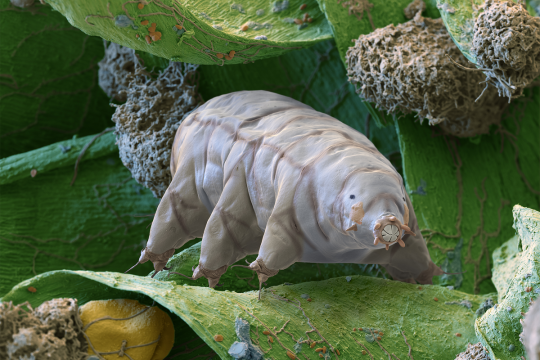
(Image: an electron microscope image of a tardigrade standing on a bit of plant matter. This one has a closed mouth with a ring of triangular tooth-like structures. It also has two simple eyes that look like black dots. End ID)
The name "tardigrade" means "slow walker", which is fitting as, despite their eight legs, tardigrades have a slow and awkward gait. This is the result of their legs being unjointed, only able to pivot at their connection to the body. Their gait has been compared to that of bears, hence why they are often called water bears and their discoverer, Johann August Ephraim Goeze, called them "kleiner wasserbär", meaning "little water bear". Tardigrades are found worldwide and have inhabited virtually every habitat, from the tops of mountains to the deep sea, from hot springs to the antarctic, from freshwater to saltwater. The one thing they have in common is a need to stay wet. Tardigrades can survive out of water as long as they can stay moist and are often found in mosses, hence another common name: moss piglets. The majority either eat plants or bacteria, but some will feed on smaller tardigrades or other micro-animals. Their famous survivability makes it easy for tardigrades or their eggs to be carried to new habitats by larger animals or other phenomena. Tardigrades are one of the first micro-animals to colonize a new habitat and they are a pioneer species, the first species to colonize a new environment and whose presence makes that environment fore suitable for other species to follow. Tardigrades are a major food source to other micro-animals and larger organisms. Most species have distinct males and females, though a few reproduce through parthenogenesis. In most cases, molting female will lay her eggs in her shed cuticle and males will them fertilize them. Other species have a form of internal reproduction. Males and females will court each other before mating and females will usually allow multiple males to fertilize her eggs. Female tardigrades are typically larger and more abundant than males. Eggs can take up to 14 days (species dependent) before hatching. All tardigrades of the same species have the exact same number of cells as each other. They are also born with the same number of cells they will have as an adult. Their growth is driven by enlargement of the existing cells rather than cellular reproduction making new cells. The lifespan ranges between a few months to a few years, depending on species.

(Image: a color photo of a tardigrade. It is a pale, translucent white, making it hard to make out details. Its body is curved, with the front end pointing at the camera. It has two simple eyes. End ID)
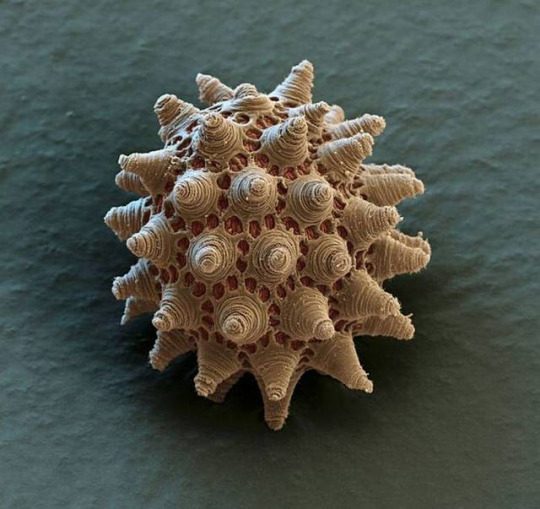
(Image: an electron microscope image of a tardigrade egg. It is round but covered in small pores and conical structures. End ID)
The most famous feature of tardigrades is their legendary durability. It is commonly said that tardigrades can survive just about anything (except for the things that are actually trying to kill them. They are prey to a lot of species after all). Among the things they can survive is extreme heat, extreme cold, dehydration, extremely high and low pressure, exposure to ionizing radiation (that's the scary kind), low oxygen environments, environmental toxins, heavy impacts, and the vacuum of fucking space. While the can survive in extreme conditions, tardigrades are not considered extremophiles. True extremophiles thrive in extreme environments and are negatively impacted by leaving them. Tardigrades can survive in extreme environments, but are negatively impacted and can't survive as well there as they can in less extreme places. The main trait that has allowed tardigrades to survive all five mass extinctions in history is cryptobiosis. Cryptobiosis is the rare ability for an animal to enter a state of dormancy where their metabolic processes come to an almost complete stop. While in cryptobiosis, metabolic activity drops to 0.01% normal and water content drops to 1% normal. In this state, the tardigrade is called a tun. Tardigrades usually enter cryptobiosis in response to arid conditions. One experiment showed that a species of tardigrade could last for at least 30 years in this state and return to normal lifestyle functions when exposed to water. Tardigrades will also enter cryptobiosis in response to low oxygen, toxic chemical exposure, increased or decreased temperature, and excessive salt content in the water. Tardigrades also show extreme resistance to both high and low pressure. They can live in 0 atmospheres of pressure and some species can survive up to 6,000 atmospheres, more than double the pressure at the bottom of the Marianas trench. More interesting is their ability to survive dangerous radiation. They can survive 1,000 times the dose of gamma radiation that humans can. Early tests focused on tardigrades in cryptobiosis and concluded that the extremely low water content of a cryptobiotic tardigrade doesn't leave much opportunity for the radiation to react with the animal. However it was later found that active and fully hydrated tardigrades are still considerably resistant to radiation. Studies into this resistance indicate that tardigrades can very efficiently repair damaged DNA and have unique proteins called Dsup that provides additional protection. Dsup introduced to human cells has provided additional protection against x-rays.
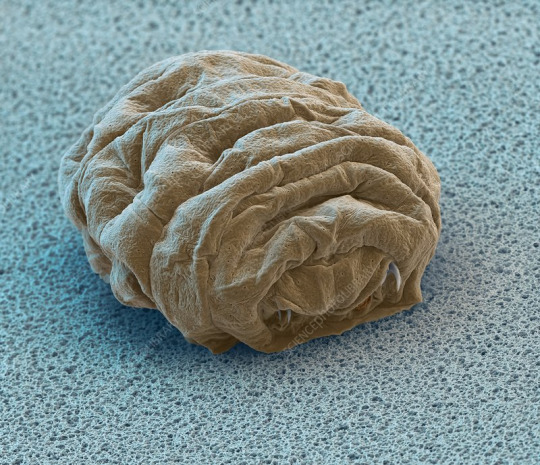
(Image: an electron microscope image of a tun - a tardigrade in cryptobiosis. It is smaller and very wrinkly, with the legs and mouth retracted into the body. End ID)
Tardigrades were the first animals to be exposed to the vacuum of space. They were exposed for 10 days, some in a state of cryptobiosis at the time of exposure and some still active. It was found that they were able to survive the vacuum when shielded from the sun's ultraviolet radiation, with those already in cryptobiosis doing better. Upon being rehydrated, many were able to resume normal life functions and successfully reproduce, though others died after being rehydrated. Those that were exposed to UV radiation fared much worse, with only a few hydrated individuals surviving. The individuals in cryptobiosis had a lower survival rate when exposed to UV than those not exposed to UV and were less successful at reproducing afterwards. Studies of tardigrade's space survival abilities and resistance to radiation could go a long way in helping human space travel. One of the largest dangers of space travel is that space is full of nasty radiation from the sun that Earth's magnetic field protects us from. Some scientists speculate about the possibility of accidentally seeding other planets or moons with tardigrades or other space-resistant organisms. This is a problem because introducing Earth life to other world has the potential to damage any native ecosystems and if we find life in space in the future we don't want to have to figure out if it's something we accidentally put there. While tardigrades could likely survive on other planets, they would eventually die without a food source. Some sources reported that tardigrades may have colonized the moon after an experiment with them crashed. Unfortunately, the moon is not crawling with tardigrades now. It's way too dry for them to exit cryptobiosis even if they survived the crash, which they probably didn't.
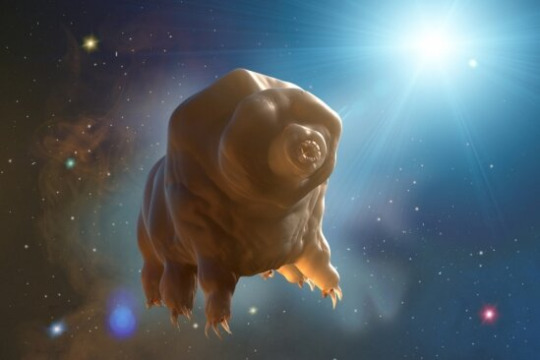
(Image: art of a tardigrade floating in the vacuum of space. End ID. Source: University of California - Santa Barbara)
#wet beast wednesday#tardigrade#water bear#moss piglet#micro animal#microbiology#marine biology#biology#zoology#ecology#animal facts#informative#science#space#astrobiology#radiation#cryptobiosis#tun#image described
155 notes
·
View notes
Text

never look back
#artists on tumblr#photography#astrophotography#astronomy#astro observations#astro community#astro tumblr#astronomical observation#astronomical objects#astronomers#cosmos#space#universe#galaxy#outer space#cosmic dreams#planets#cosmic secrets#cosmic stories#infinite#infinite universe#journey to the end of the cosmos#astrobiology#spaceships#space suits
158 notes
·
View notes
Text

listen to me
#battle for dream island#bfdi#bfb#tpot#fireoiny#woodblock#floweafy#treehole#astrobiology#lightning x snowball#matchcil#bookcube#4x#fubble#sawgaty
488 notes
·
View notes
Text
Astrobiology or smth, idk, i just wanted an excuse to draw BH
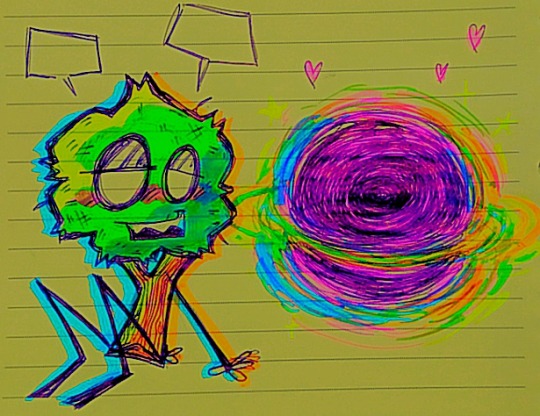
176 notes
·
View notes
Text
Orion & Horsehead Nebula

#astronomy#nasa#astronomers#universe#astrophotography#nasa photos#astrophysics#outer space#nasawebb#hubble space telescope#deep sky#sky#i love astronomy#astronomy facts#astrography#astrobiology#astronauts#planetary science#space program#space travel#space science#space exploration#space#space photography#science facts#galaxies#galaxy#planetary nebula#cosmos#astro observations
51 notes
·
View notes
Text

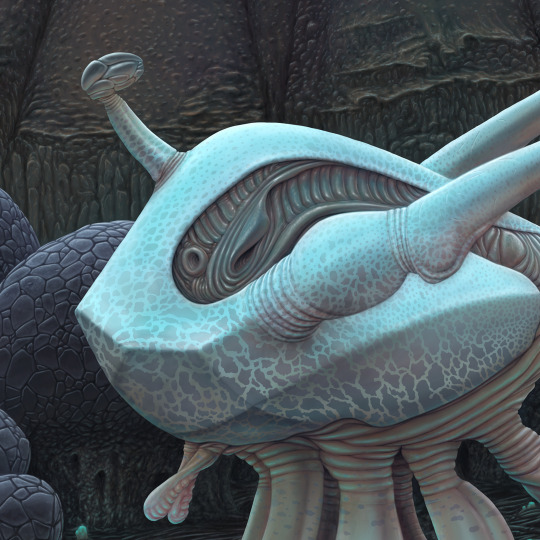
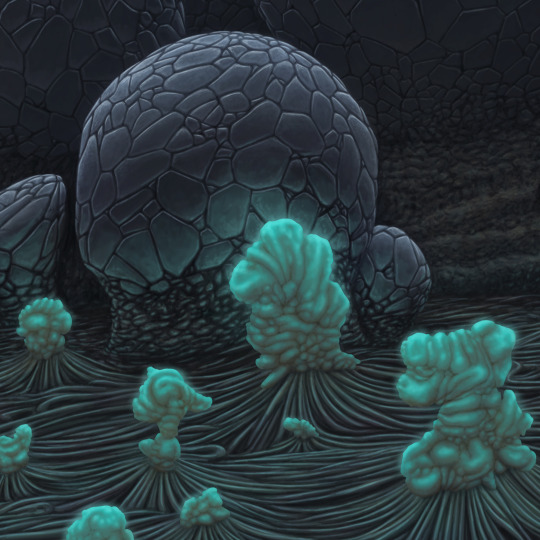

In the Shadow of Colossus
Veteris is a geologically dynamic world, with active plate tectonics that thrust huge mountains high into the sky. One of the highest ranges is Colossus, which contains peaks well over 50,000 feet tall. Here on its outskirts, deep valleys have formed, whose unfortunate position robs them of sunlight for most of the daytime.
These twilight conditions are not favorable for creatures with high photosynthetic needs, but provide opportunities for others. The ominous Valley Plate-globes are covered in dark panels that absorb as much sunlight as possible during the short daylight hours. Rising far above the ground are the Skycolumns, who extend their fleshy fronds when the sun is directly overhead. Their main body column is heavily buttressed to prevent being toppled by strong winds.
The particular species of tube carpet that covers the valley floor grows a large glowing bulb which carries a multitude of its microscopic embryos. Once the bulb reaches a certain size and luminosity, it attracts the attention of mobile creatures, who by eating it spread the tube carpet’s offspring far and wide. The primary patron at this bioluminescent buffet is the Ghost Celeriarma, a swift and well-defended denizen of the shadow lands. Like many inhabitants of Veteris, it utilizes a combination internal/external support structure that is both flexible and strong. A turret of eyes extends high above the rest of its body and gives it 360 degree surveillance capability. If eyesight should fail to detect a predator, its quick speed and sharp, moveable spines may keep it safe.
A far less athletic creature, the smaller Pluriped has instead developed camouflage to avoid predation. Lateral markings and a glowing bulbous growth of its own help it blend in to the shadowy sea of tube carpet.
#art#space#alien#creature#artist#creature design#exobiology#speculative evolution#speculative biology#astrobiology#worldbuilding
679 notes
·
View notes
Text
Hidden beneath the heavily cratered surface of Mimas, one of Saturn's smallest moons lies a secret: a global ocean of liquid water. This astonishing discovery, led by Dr. Valéry Lainey of the Observatoire de Paris-PSL and published in the journal Nature, reveals a "young" ocean formed just 5 to 15 million years ago, making Mimas a prime target for studying the origins of life in our solar system.
"Mimas is a small moon, only about 400 kilometers in diameter, and its heavily cratered surface gave no hint of the hidden ocean beneath," says Dr. Nick Cooper, a co-author of the study and Honorary Research Fellow in the Astronomy Unit of the School of Physical and Chemical Sciences at Queen Mary University of London.
Continue Reading.
133 notes
·
View notes
Text

My silly billies
#ugh stop astroing on my biology#fanart#bfb black hole#bfdi#tree tpot#tpot tree#tpot black hole#astrobiology#tpot#bfb#osc
194 notes
·
View notes